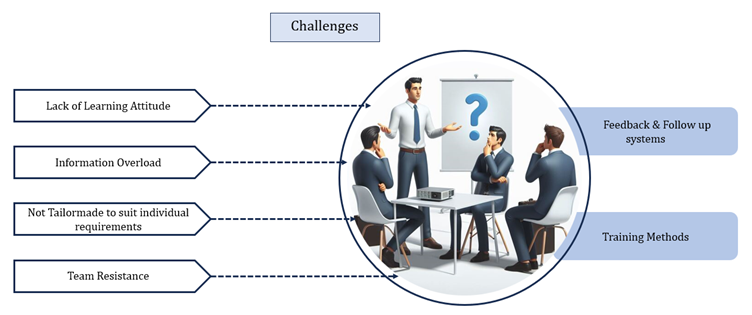
Unlocking Potential: The Critical Role of Attitude in Training and Mentoring
As consultants, we’re no strangers to the familiar request from clients: ‘Can you provide or suggest the experts for training to our team to improve performance?
It’s a common inquiry, and on the surface, it seems straightforward. Yet, behind this seemingly simple request lies a complex reality. While training holds immense potential to enhance team performance and drive organizational success, the path to achieving these outcomes is fraught with challenges.
Attitude and Mindset: One of the most significant hurdles in training initiatives is the attitude and mindset of team members. Resistance to change and a lack of enthusiasm for learning can hinder the effectiveness of training programs.
Lack of Commitment: Without a genuine commitment from employees to fully engage in the training process, efforts to improve performance through training may fall flat.
Organizational Culture: The prevailing culture within an organization can either support or undermine training efforts. In cultures where learning and development are valued and encouraged, training initiatives are more likely to succeed. However, in cultures where training is seen as an afterthought or where there is a fear of failure, implementing effective training programs becomes challenging.
Lack of Clear Goals and Objectives: Training initiatives are most effective when they are aligned with clear goals and objectives. Without a clear understanding of what the training is intended to achieve and how it fits into the broader organizational strategy, employees may struggle to see the relevance and value of the training.
Limited Feedback and Follow-up: Effective training programs require ongoing feedback and follow-up to ensure that employees are able to apply what they have learned on the job. Without adequate feedback mechanisms in place or follow-up support, employees may revert to old habits or fail to fully implement new skills and knowledge.
Addressing these hurdles requires a comprehensive approach that goes beyond simply providing training sessions. It involves fostering a culture of learning and development, gaining buy-in from leadership, allocating sufficient resources, setting clear goals and objectives, and providing ongoing support and feedback to employees. By addressing these challenges head-on, organizations can maximize the effectiveness of their training initiatives and ultimately improve team performance.

In the competitive landscape of modern workplaces, the mantra “knowledge is power” rings truer than ever. Training initiatives promise enhanced skills, improved performance, and ultimately, business success. Yet, beneath the surface of training lies a critical factor that can make or break its effectiveness: Attitude.
The Power of Attitude in training:
A Foundation for Growth: Imagine training programs as seeds planted in the fertile soil of a team’s attitude. A positive, receptive attitude serves as the nourishing bedrock for these seeds to sprout and flourish. When team members approach training with curiosity, enthusiasm, and a hunger for growth, the potential for improvement becomes limitless. They absorb knowledge like sponges, apply new skills with gusto, and fuel a cycle of continuous learning and advancement.
Catalyst for Innovation: In today’s rapidly evolving landscape, innovation is the lifeblood of success. However, innovation thrives in environments where team members are open to new ideas and unafraid of experimentation. Training programs act as catalysts, igniting the spark of innovation within teams. But without the right attitude, this spark may fizzle out. Teams with a stagnant mindset may resist change, stifling creativity and hindering progress.
The Dark Side of Training Without the Right Mindset:
Wasted Resources: Training programs represent a significant investment of time, money, and resources. However, if team members lack the right attitude, these investments may go to waste. Imagine a scenario were employees approach training with apathy or skepticism. They attend sessions begrudgingly, disengage during activities, and fail to apply learnings in their roles. Despite the resources poured into training, the desired outcomes remain elusive, leaving stakeholders disillusioned and budgets depleted.
Cultural Erosion: Training initiatives not only shape individual skill sets but also contribute to organizational culture. Yet, when team members exhibit a negative attitude towards learning, the fabric of organizational culture begins to fray. Resentment festers among those who perceive training as a chore rather than an opportunity. Over time, this toxic mindset spreads, eroding morale, teamwork, and ultimately, the company’s culture.
The Synergy of Training and Mentoring:
Guiding Lights of Experience: Mentoring serves as a guiding light, illuminating the path of growth and development for team members. When top-level leaders take on the role of mentors, they impart invaluable wisdom, insights, and guidance gleaned from years of experience. Mentoring goes hand in hand with training, providing a personalized touch that bridges the gap between theory and practice. Through mentorship, trainees gain not only knowledge but also perspective, empathy, and a roadmap for success.
Cultivating a Culture of Excellence: In organizations where mentoring and training are intertwined, a culture of excellence takes root and flourishes. Leaders lead by example, demonstrating a commitment to lifelong learning and growth. They invest in their teams, nurturing talent and potential at every level of the hierarchy. By prioritizing mentorship alongside training, these organizations create a ripple effect of positivity, empowerment, and high performance.
In conclusion, the success of training initiatives hinges on more than just content and delivery—it hinges on attitude. A team’s receptiveness to learning, coupled with the guidance of mentors, forms the bedrock upon which performance and success are built. As organizations strive to unlock their full potential, they must remember that training without the right mindset is like trying to light a fire without oxygen—it may spark briefly, but it won’t sustain the flames of progress.
